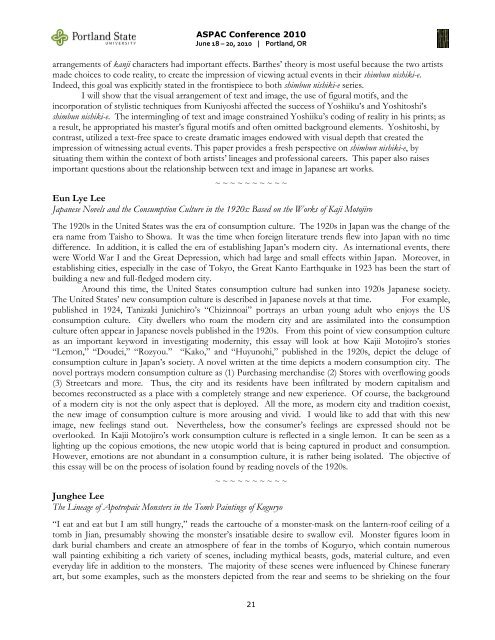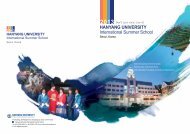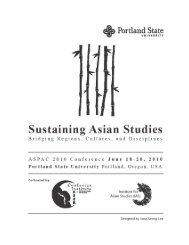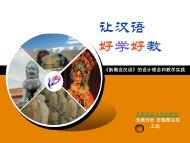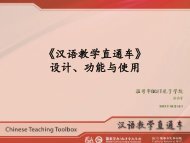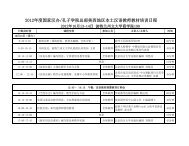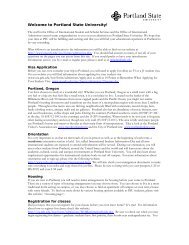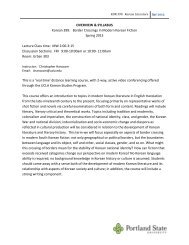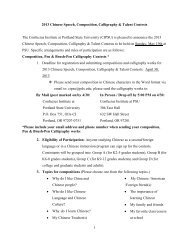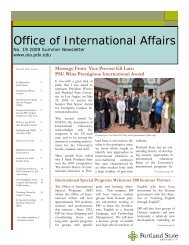ABSTRACTS - oia - Portland State University
ABSTRACTS - oia - Portland State University
ABSTRACTS - oia - Portland State University
You also want an ePaper? Increase the reach of your titles
YUMPU automatically turns print PDFs into web optimized ePapers that Google loves.
ASPAC Conference 2010<br />
June 18 – 20, 2010 | <strong>Portland</strong>, OR<br />
arrangements of kanji characters had important effects. Barthes’ theory is most useful because the two artists<br />
made choices to code reality, to create the impression of viewing actual events in their shimbun nishiki-e.<br />
Indeed, this goal was explicitly stated in the frontispiece to both shimbun nishiki-e series.<br />
I will show that the visual arrangement of text and image, the use of figural motifs, and the<br />
incorporation of stylistic techniques from Kuniyoshi affected the success of Yoshiiku’s and Yoshitoshi’s<br />
shimbun nishiki-e. The intermingling of text and image constrained Yoshiiku’s coding of reality in his prints; as<br />
a result, he appropriated his master’s figural motifs and often omitted background elements. Yoshitoshi, by<br />
contrast, utilized a text-free space to create dramatic images endowed with visual depth that created the<br />
impression of witnessing actual events. This paper provides a fresh perspective on shimbun nishiki-e, by<br />
situating them within the context of both artists’ lineages and professional careers. This paper also raises<br />
important questions about the relationship between text and image in Japanese art works.<br />
~ ~ ~ ~ ~ ~ ~ ~ ~ ~<br />
Eun Lye Lee<br />
Japanese Novels and the Consumption Culture in the 1920s: Based on the Works of Kaji Motojiro<br />
The 1920s in the United <strong>State</strong>s was the era of consumption culture. The 1920s in Japan was the change of the<br />
era name from Taisho to Showa. It was the time when foreign literature trends flew into Japan with no time<br />
difference. In addition, it is called the era of establishing Japan’s modern city. As international events, there<br />
were World War I and the Great Depression, which had large and small effects within Japan. Moreover, in<br />
establishing cities, especially in the case of Tokyo, the Great Kanto Earthquake in 1923 has been the start of<br />
building a new and full-fledged modern city.<br />
Around this time, the United <strong>State</strong>s consumption culture had sunken into 1920s Japanese society.<br />
The United <strong>State</strong>s’ new consumption culture is described in Japanese novels at that time. For example,<br />
published in 1924, Tanizaki Junichiro’s “Chizinnoai” portrays an urban young adult who enjoys the US<br />
consumption culture. City dwellers who roam the modern city and are assimilated into the consumption<br />
culture often appear in Japanese novels published in the 1920s. From this point of view consumption culture<br />
as an important keyword in investigating modernity, this essay will look at how Kajii Motojiro’s stories<br />
“Lemon,” “Doudei,” “Rozyou.” “Kako,” and “Huyunohi,” published in the 1920s, depict the deluge of<br />
consumption culture in Japan’s society. A novel written at the time depicts a modern consumption city. The<br />
novel portrays modern consumption culture as (1) Purchasing merchandise (2) Stores with overflowing goods<br />
(3) Streetcars and more. Thus, the city and its residents have been infiltrated by modern capitalism and<br />
becomes reconstructed as a place with a completely strange and new experience. Of course, the background<br />
of a modern city is not the only aspect that is deployed. All the more, as modern city and tradition coexist,<br />
the new image of consumption culture is more arousing and vivid. I would like to add that with this new<br />
image, new feelings stand out. Nevertheless, how the consumer’s feelings are expressed should not be<br />
overlooked. In Kajii Motojiro’s work consumption culture is reflected in a single lemon. It can be seen as a<br />
lighting up the copious emotions, the new utopic world that is being captured in product and consumption.<br />
However, emotions are not abundant in a consumption culture, it is rather being isolated. The objective of<br />
this essay will be on the process of isolation found by reading novels of the 1920s.<br />
~ ~ ~ ~ ~ ~ ~ ~ ~ ~<br />
Junghee Lee<br />
The Lineage of Apotropaic Monsters in the Tomb Paintings of Koguryo<br />
“I eat and eat but I am still hungry,” reads the cartouche of a monster-mask on the lantern-roof ceiling of a<br />
tomb in Jian, presumably showing the monster’s insatiable desire to swallow evil. Monster figures loom in<br />
dark burial chambers and create an atmosphere of fear in the tombs of Koguryo, which contain numerous<br />
wall painting exhibiting a rich variety of scenes, including mythical beasts, gods, material culture, and even<br />
everyday life in addition to the monsters. The majority of these scenes were influenced by Chinese funerary<br />
art, but some examples, such as the monsters depicted from the rear and seems to be shrieking on the four<br />
21


